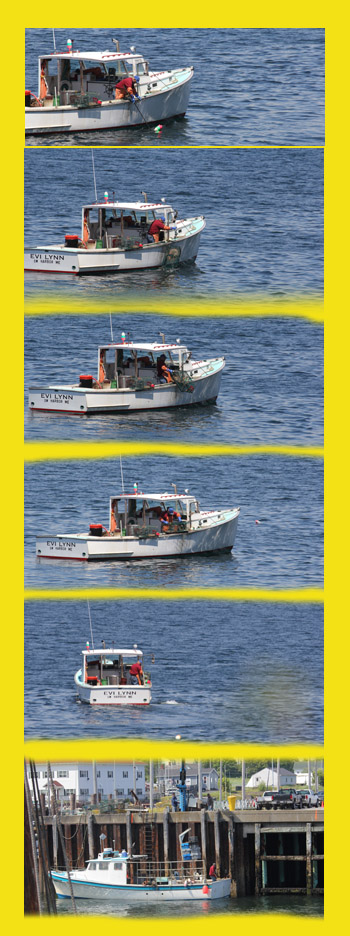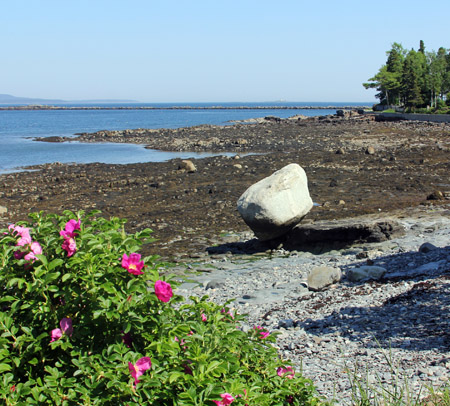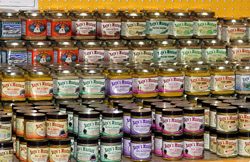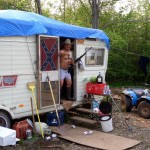By Barry Zander, Edited by Monique Zander, the Never-Bored RVers
Maine is beautiful, or at least what we’ve seen of it – take my word for it. This week we arrived at Acadia National Park, reputed to be one of America’s best. We’ll await our RV caravan tour via bus in a couple of days to pass final judgment, but it’s looking great so far.
Two things keep striking me as notable since our arrival in Maine: geology and communications.
In this, our 48th state to visit as RVers (Ohio and Hawaii are in the offing), I don’t remember ever seeing such dramatic evidence of the Ice Age, which swept across the upper reaches of North America until 18,000 to 10,000 years ago after millions of years of covering this land. Today we drove by Somes Sound, carved out by the gargantuan glaciers to form the only fjord on America’s East Coast. It is essentially a deep gorge that has filled with seawater.
As a well-traveled tourist, I found Somes to be one of the most striking inlets we’ve seen, with it’s blue and blue-green waters serving as harbor to numerous small boats.

A lobsterman pulls in his catch, selects the keepers, and returns the trap to the Somes Sound. The bottom shot is of a boat being unloaded at Eastport two days earlier.
It was also while standing at an overlook that we saw a lobster boatman in action – retrieving a float, lifting the float and eventually the lobster trap into his boat, tossing out those that were undersized, emptying the trap into the boat and throwing it back into the water. Having had personal association with the fruits of his labor, it was interesting to see the process that got it from sea to campground table.
At our previous stop in Eastport, Maine, we were on the docks when a lobster boat pulled up to the dock, where his hampers were lifted onto a waiting truck parked on the wharf to be shuttled to the Quoddy Bay Lobster Company nearby. That’s where we bought a 2¼-pounder for our dinner. Ah, the Circle of Life!

Geologists have learned that this rock at Bar Harbor, Maine, was actually carried to this resting place by a glacier from 40 mile away..
Back to geology. The bald tops of hills in upper New England show clear evidence of being scourged by those Ice Age glaciers. Boulders and rocks – often massive weighing several tons – sit randomly on land and in the water as constant reminders that this land was once beneath thousands of feet of solid ice, and moved along very, very slowly by advancing and then receding glaciers.
For those of us who are dismayed at seeing the obvious retreat of high mountain ice floes in Glacier National Park and other venues in the West, we can take comfort in knowing that, although they will return, it won’t be for another 10 millennia or maybe more.
I think you’ve had enough geology for the moment, so now let’s return to Eastport and the trying communications situation we encountered there.
At the Seaview Campground at Eastport, we were close enough to Canada that my cellphone found a Canadian-based tower. A few hundred yards away and in sight of our trailer we could get AT&T. And in between it kept switching back and forth for no apparent rhyme or reason. Then there was the Internet connection or lack thereof. The campground provided a service with free connection for 30 minutes, after which it cost money – not a lot, but an inconvenience when it didn’t allow me to get online.
We’re now in Acadia National Park’s Blackwoods Campground, where I can pick up a bar or two of cellphone service using my signal booster. For regular travelers to remote spots, this is something you might find worth the investment.
And finally, two more quick topics. In preparation for our trip into Canada, we had a car dealership check over our truck and make any corrections needed. Wednesday, Monique noticed that one of the front running lights on the truck was out. A minute later we saw Darling’s GMC dealership in Ellsworth in front of us. You can imagine my concern over cost and time; but, instead, the service manager pointed me to the parts counter and said, “Get the bulb and we can pop that in for you.” We’ve had a few similar situations this trip, all of which bears mentioning. It renews our appreciation for human kindness along the roads of America.

A few of Raye's Mustard varieties.
While in Eastport, we “toured’ the one room of Raye’s Mustard Mill. Because it’s a classic small operation using traditional equipment and man-and-woman power to get the 28 mustard products from mill to grocery stores, I couldn’t understand why photos of the operation weren’t allowed. I mean, French’s and Grey Poupon would probably not choose to step back in time to use Raye’s family-operation methods. However, the quality of their mustards is on display in the many awards won over the years, including in top international competitions.
We’ve taken maybe a half-dozen factory tours of one kind or another. We may forget all that we’ve seen (well, maybe not Harley-Davidson or Ben & Jerry’s), but it’s definitely part of the reason that we’re the “Never-Bored RVers,” We’ll see you on down the road.
© All photos by Barry Zander. All rights reserved
COMMENTS FROM READERS
From Bill Baxter — Belted Galloways is the breed. Kept primarily for dairy, good butterfat maybe 5-5.5%, which meant a higher price. There is another herd in Richmond, Maine. We don’t think weird looking, just different and actually quite pretty.
Regarding the reversing falls at Pembroke. Not like the tidal bores you can see further up the Bay of Fundy. Since the entire drains through the ‘falls’ it is a 12-hour-plus cycle to see the whole. But even to see the tidal flow change is quite spectacular. First time we saw the ‘falls,’ it was about three hours into an outgoing tide. About two hours later we noticed that the water level near the shore on both sides appeared to be rising. Ah, yup it sure was. Got to be about 7-10 feet higher on the sides than in the center channel. Then all of a sudden as the water level on the sides reached the bay water level the center filled quickly and the flow could seen to be incoming.
Enjoy the Maritimes. Remember to drive the Gaspe Peninsula in a CCW direction. Keeps you on the water side of the highway. Truro has a great tidal bore in the city park.
From Craig Dresser — Hello Barry and Monique, I have learned so much from reading your articles and have gotten some great travel ideas, and even though I have visited the coast of Maine as far north as Bar Harbor, i didn’t know there was a 6th time zone in North America named Atlantic! I also enjoyed your article over the weekend regarding traveling with a Caravan and that has given me food for thought when we travel to Canada.
One thing in your article today caught my attention and I thought I should bring it up, simply to supply correct information. The “Banded Calloways” you mentioned are really called Belted Galloways. I know this because I have a friend with the last name Galloway, and I took great delight in teasing her with a picture I took of the cows while visiting Rockport, ME, a few years back. Here’s a link to the U.S. Belted Galloway Society if you’re interested: http://www.beltie.org Thanks again for the great articles!
From Joyce and James “Butterbean” Carpenter — Howdy M&B, Did you have ‘lobstah’ again?? They’re really just big ‘mudbugs’, ya know!!! The pics are really great, Barry … We sure are enjoying our ‘free’ trip up in the FAR NE part of Texas!!! You are a good travel agent and tour operator!!! Do they make ‘lobstah’ po-boys up there? Hope y’all have a HAPPY DAY !!!!
From Drew — Barry and Monique, I really enjoyed your pictures of the sea and coast. It looks like a very relaxing trip. It’s amazing to recall that Schooners were once used to ship freight between coastal towns.
Because of the numerous Spam comments on this site, the comments section has been deactivated. Please email us at [email protected] and I will pass along your comments. Learn about Alaska and see travel photos at ontopoftheworld.bz (and much more to come when time allows).
